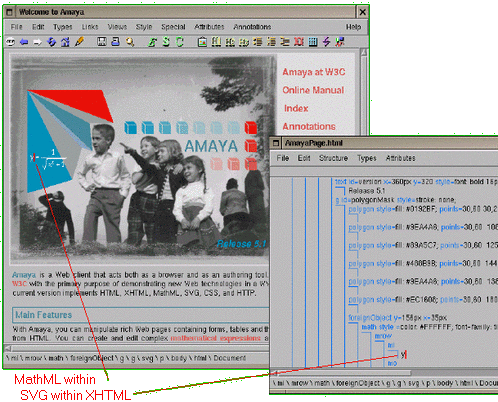


Amaya
Activity Statement
Starting from April 16, 2003, Amaya stopped being a W3C Activity, as
defined in the W3C Process
Document. Amaya continues as an Open Source project, with its main
contributors being W3C and INRIA. Development of Amaya inside W3C has moved
on to the Systems Team.
- Introduction
- Amaya at W3C
- What the Future Holds
- Contact
Amaya is W3C's own full-featured Web client. Amaya integrates a browser, a
"WYSIWYG" authoring tool, and gives direct access to Web servers (get/put).
It provides developers with many specialized features including multiple
views, where the internal structural model of the document can be displayed
alongside the browser's view of how it should be presented on the screen.
Amaya puts the focus on integrating Web technologies. An important benefit
of Amaya is that it implements W3C specifications very carefully. This allows
Web authors to make sure they are producing correct markup, which is easy to
maintain or re-purpose for other devices. A more important benefit is that it
lets authors mix W3C technologies and edit them in a uniform way (uniform
representation, uniform commands).
Amaya is developed at W3C as an Open Source project. Core team include
Irène Vatton, José Kahan, Laurent Carcone, and Vincent Quint. It is used by
several groups within the Consortium to demonstrate their work. As an
experimental platform, Amaya plays an important role in the areas of:
- HTML: The way Amaya handles documents strictly follows
Document Type Definitions. As an editor, it is guaranteed to produce
compliant code. It handles HTML 4.01 documents but also XHTML 1.0 (Transitional, Strict, or Basic) and XHTML 1.1 documents, including both simple and
complex ruby annotations. Menus are automatically
customized according to the current profile of the document being edited
and the author is assisted when s/he wants to change the profile of a
document.
- HTTP protocol: Amaya accesses remote sites by means of
HTTP/1.1, as implemented in libwww. It takes advantage
of the most advanced features of HTTP, such as digest authentication to
allow secure browsing, pipelining to save network bandwidth, and
conditional requests using etags to allow cooperative remote publishing.
Experimental support of WebDAV is also provided.
- MathML: The presentation markup of MathML is implemented which allows users to
browse and edit Web pages containing complex mathematical expressions.
Amaya handles isolated MathML documents, but also XHTML and XML pages
that include mathematical expressions through the use of namespaces.
Special attention has been paid to the tight integration of mathematics
within text.
- SVG: Amaya provides limited support of Scalable Vector
Graphics (SVG). These
graphics, written in XML, may be mixed freely with XHTML and MathML
markup. The screen below shows how you can display graphics including
mathematical expressions on the screen side by side with the
corresponding XML markup.

- Style sheets: Amaya has extensive support for the W3C
style sheet language CSS. A
simple-to-use interface helps users to write style sheets for Web
documents while hiding some details of the syntax associated with style
sheet rules and properties. You can create colored text, change the font,
set the background color and control other presentational effects. CSS
style sheets may also be used to alter the look of any XML documents.
- Internationalization: Users can select the dialogue
language through a configuration menu (currently English, French, German,
Spanish, Portuguese, Italian, and Finnish). Other languages based on the
Latin script may be added by users without recompiling the application.
Amaya supports a large set of document encodings (UTF-8, ISO-8859-*,
Windows, JIS, etc.), bidirectional writing, and multilingual documents.
It takes the current language into account when spell-checking or
hyphenating.
- XLink: Simple unidirectional hyperlinks are available
in HTML by means of anchors. XML Linking Language (XLink) is used for setting unidirectional
hyperlinks from MathML, SVG or any other XML elements.
- RDF, XPointer: Amaya includes a collaborative
annotation application based on the Resource Description Framework (RDF), XLink, and XPointer. Annotations are external
comments, notes, and remarks that can be attached to any Web document or
a selected part of the document. Annotations are stored either locally or
into annotation servers. The creation of annotations on a document
doesn't modify the document itself.
- XML: Amaya is able to read any XML documents and to
format such documents through CSS style sheets.
The current public release is Amaya 8.0 (15 April 2003) and is available
both in source code and ready to use forms. The latest available
snapshot dates from 21 February 2003. The Amaya software is written in C and
is available for Windows, Unix platforms and Mac OS X. It can be freely downloaded from the W3C site.
Documentation is provided at every level, catering for the beginner right
through to the developer wanting to extend the software for their own
purposes.
The Amaya CVS base is publicly available. It
has world read-only access, but write access may be opened to other
developers.
The plan is to continue our effort on XML, in particular the editing of
generic XML documents and their association with CSS style sheets. At the
same time, significant progress on SVG editing is expected. Future releases
will provide more complete support of SVG, better rendering, and a suitable
editing interface.
Important work on the WebDAV support in Amaya is in progress and will be
released in a future version.
The team will continue to work with other W3C Activities to help
demonstrate and test new developments in a variety of areas.
